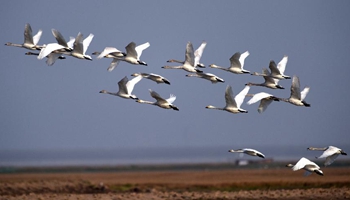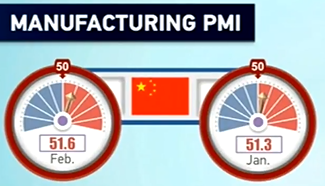BEIJING, March 3 (Xinhua) -- With shipping on the Wu River resumed after a 13-year suspension, landlocked Guizhou Province in the mountains of southwest China has reached out to the Yangtze through the Wu, its biggest tributary.
Produce and staples once dependent on rail and road are now being taken by ship to Chongqing for distribution to elsewhere in China and abroad.
With low shipping costs, factories have started to accumulate along the Wu and industrial parks are being built. With only a few local cargo boats, shipbuilding is also on the rise.
"The waterway has invigorated the local economy and allows Guizhou to make the most of the Yangtze River economic belt," said Han Jianbo, deputy chief of Guizhou transportation bureau.
A LAND LOCKED NO MORE
Of the nine provinces and two municipalities in the economic belt, Guizhou is the only one which is not actually on the Yangtze. Since November when the Wu opened again, Guizhou has integrated itself with the economic belt that covers 20 percent of China's territory and contributes more than 40 percent of economic growth.
In 2008, the province began to invest heavily in the Wu navigation channel, dredging 430 km of the waterway and building berths, navigation facilities and huge ship elevators to raise boats up to 200 meters.
Navigation was suspended in 2003 when Goupitan hydropower station opened and the water level differential arose. Now water transit has resumed, annual freight volume is expected to hit 15 million tonnes in three years and 100 million tonnes by 2030.
Governor Sun Zhigang believes the province is well on the way to unprecedented economic development. Last year, when Guizhou became a pilot for the opening-up of inland provinces to alleviate poverty and develop new industries, the local economy grew by 10.5 percent, the second highest in the country.
All the less-developed provinces along the Yangtze saw their economies grow much faster than the national average last year, with Jiangxi registering a rise of 9 percent, Yunnan and Anhui both at 8.7 percent, Hubei at 8.1 percent and Hunan at 7.9 percent.
Lin Qidong of the Chongqing Transportation Bureau said new infrastructure along the Yangtze had already been a powerful boost to the inland provinces, and great potential remains.
INTEGRATION BRINGS EXPANSION
Guoyuan, a 16-berth port connected to the railway in Chongqing, shipped 12 million tonnes of freight last year, but can handle up to 30 million tonnes. Every day, cargo shipped from Guangxi, Guizhou, Jiangsu, Shaanxi, Sichuan and Yunnan arrives for transfer to railroad cars, often bound for northern Europe, 16 days away.
By 2020, four new rail-water-road ports and nine specialized ports will have been built in Chongqing, and the aggregate cargo handling capacity of the municipality is expected to hit 220 million tons.
"With these new ports, the influence of the Yangtze on the economy will grow substantially," said Lin.
The Yangtze is the world's busiest river. More than 2.3 billion tons of cargo went through ports on the main stream last year, up 6 percent. This includes 330 million tonnes of exports and around 15 million containers.
Even Nanjing Port, nearly 40 years old, has shown new dynamism. Since its channel was deepened to 12.5 meters, the port's capacity has exceeded 100 million tons.
Shi Fei, director of development with Nanjing Port Group, said the deeper channel had turned Nanjing into an international port able to accommodate ships of up to 80,000 tonnage.
"When I left college and joined Nanjing Port in 1981, I never expected the port to be world-class," said Shi. "About 90 percent of the world's ships can now anchor in Nanjing."
The waterway from the estuary of the Yangtze to Nanjing was only 7 meters deep in 1998. The channel depth in Jiangsu has been gradually increased, first to 8.5 meters and then 10.5 meters, making it navigable by bulk carriers and oil tankers.
To make optimum use of the waterway, the Ministry of Transport has been encouraging the standardization of ships and development of larger ships.
CLEANER RIVER, MORE TOURISTS
Wu Song, a resident of Yichang City in the middle reaches of the Yangtze, runs www.yangtze.com and helps foreign tourists book cruises.
He has seen some major changes since the formation of the economic belt: polluting factories have been closed and water quality control is now more strict.
"Foreigners are here not just to see the river, but also Chinese culture and the lives of Chinese people. An improving environment not only benefits the locals, but attracts more visitors," he said.
"I never think of Yichang as a small town. Yichang is wide open to the world. Without the river, I would not meet so many guests from across the globe," Wu said.
As the stars of the provinces along the Yangtze rise, people are choosing to leave coastal cities in the east and return to their hometowns.
Wang Ting, a welder, worked in Shanghai for seven years. He has returned to settle down in his hometown of Wuhan, and now earns more money working in an auto part factory.
"The port of Yichang was not so crowded by migrant workers returning from Guangdong and Shanghai during this year's Spring Festival. I guess a lot more people are finding work near their hometowns and more people are now travelling by train, which is much faster than by boat," he said.
Asked about what he expects for the future of the Yangtze, Wu recalled a book written by a foreign missionary more than a century ago. At that time, the finless porpoise was often seen. Today it has all but vanished.
"I wish people would always put the environment before economic development, and the finless porpoise will come back and multiply," said Wu.












